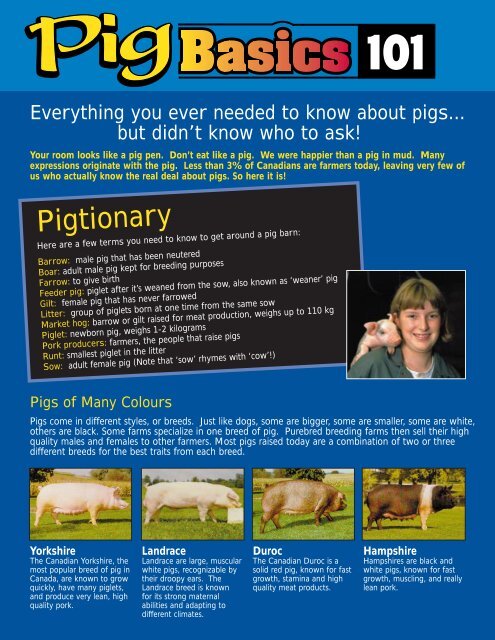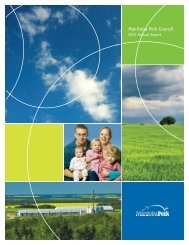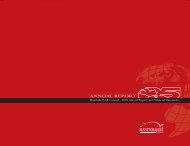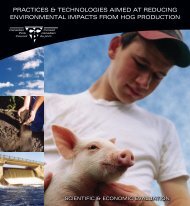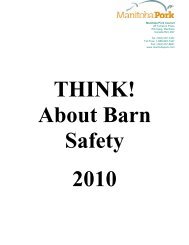Pig Basics - SaskPork
Pig Basics - SaskPork
Pig Basics - SaskPork
- No tags were found...
Create successful ePaper yourself
Turn your PDF publications into a flip-book with our unique Google optimized e-Paper software.
Let’s start at the very beginning...Sows can be bred by natural mating with boars or by artificial insemination.Artificial insemination allows farmers to buy the best genetics in the worldwithout having to bring a new animal into the barn.It’s easy to remember that a sow’sgestation (pregnancy) lasts forapproximately three months, threeweeks, and three days. The averagesow can have 8-12 piglets in a litter,and gives birth approximately twice ayear. Sows are put in special pens called‘farrowing pens’, just before giving birthand while theynurse their piglets.The farrowing penis designed to provide the best environment for both thelarge sow and the small piglets. The bars on the pengive the sow something to lean against when she liesdown, and the piglets have a safe area to stay out ofharm’s way. The area where the piglets sleep can bekept warm with a heat lamp or heat pad. Sows nursetheir piglets for two to four weeks, until the piglets areweaned from milk and eat solid food.To the nursery ...Heat LampFeeder pigs receive a diet thatchanges to meet their nutritionalneeds as they grow. Once thepiglets are weaned from the sow,they are moved to group pens inanother room or even a separatebarn altogether. These newlyweaned pigs need warmer temperatures,and are healthiest whenkept completely separate from olderpigs. These pigs are usually kept ingroups, with other pigs of the samesize. It is important to keep pigs ingroups with other pigs the samesize as they will ‘bully’ each otherand can really injure smaller pigs.BoarFarrowing PenManure and urine fall through this typeof floor to keep pens clean and dry.Slatted floor
These pigs went to market ...Farmers move the feeder pigs out of the nursery when theyreach approximately 25 kg. This next stage is called the ‘growerfinisher’section where pigs are housed in a separate room or aseparate barn designed for that size of pig. A feeder pig israised to market weight of 110 kg. These are the pigs thatsupply us with pork.Market hogs are sent to meat processing plants ontrucks designed just for pigs. There are guidelines fortransporting pigs, including the number of pigs on thetruck. For example, in hot weather fewer pigs are puton a truck and are often shipped at night or earlymorning when it is cooler.Each animal is inspected at the processing plant.<strong>Pig</strong>s are handled and euthanized quickly and humanelyby approved methods. Processing plants follow strictgovernment guidelines for processing and handling animals andmeat products. A lot of research has been done on humanehandling and euthanasia. Check out Dr. Temple Grandin’swebsite for examples: www.grandin.com.This little pig stayed home ...The pigs with the best genetics and desirable pig characteristics are called ‘breeding stock’. These pigsremain in the farmer’s herd or are sold to other farmers to add to their herd or replace existing pigs. Goodbreeding stock pigs are kept for different reasons. Farmers look for pigs with characteristics such as a goodbody and bone structure, muscling, quick growth, or strong maternal instincts.Houses of Straw, Sticks, or Bricks?Only pigs in storybooks or movies live in houses, talk, and wearclothes. Most real pigs in Canada live in barns, not outside inthe mud. Why, you ask? Barns are designed to provide pigswith the right environment, protected from extreme weatherand temperature.Sweat like a <strong>Pig</strong>?Guess what? <strong>Pig</strong>s don’t sweat! Storybook pigs are often shownin the mud as they try to keep cool and out of the sun. Real pigsactually like to keep clean. Today’s pig barns help keep pigs coolin the summer and warm in the winter with lots of fans to helpcirculate the air. Did we mention some barns even have watersprinklers to help keep pigs cool and comfortable?Temperature and fan control


